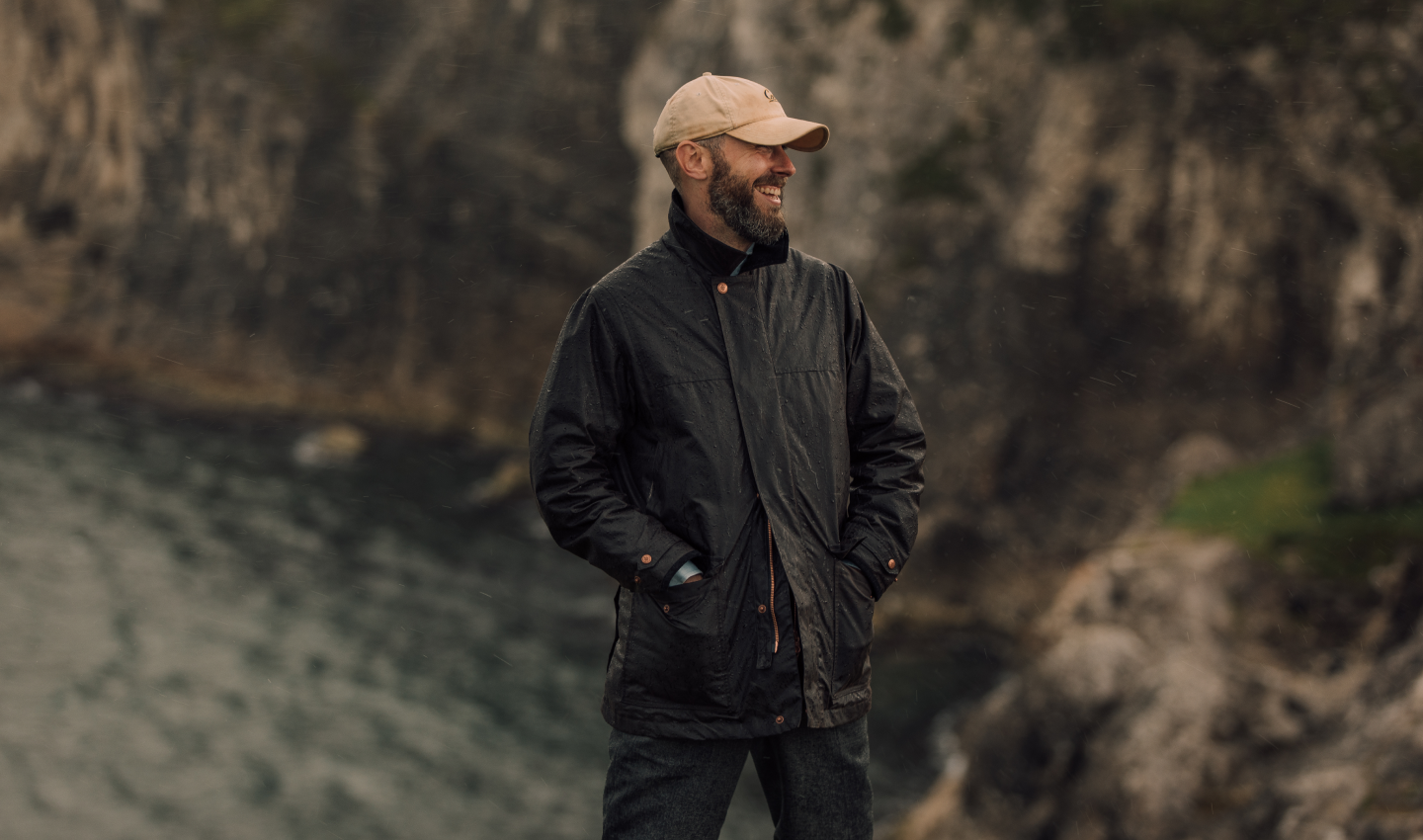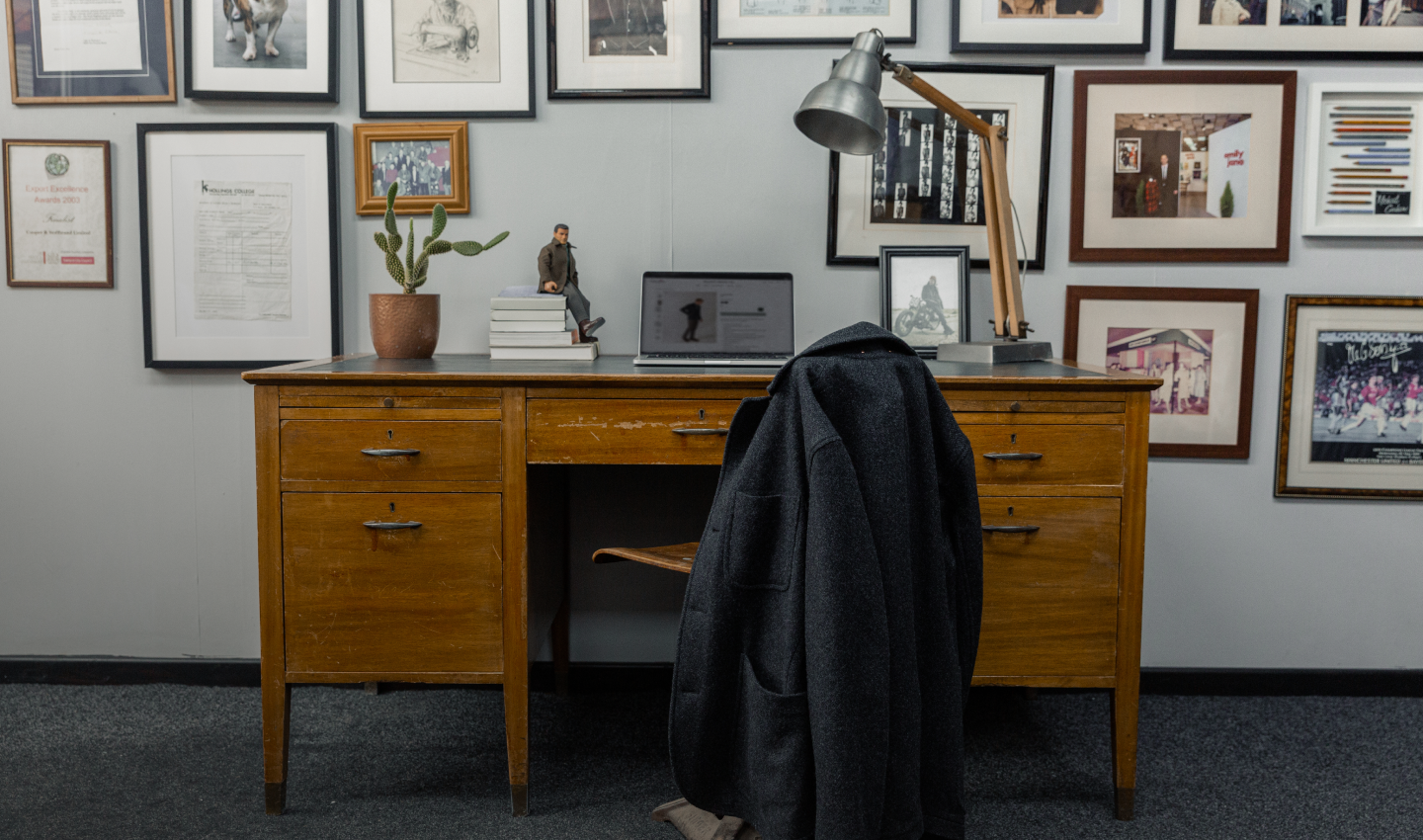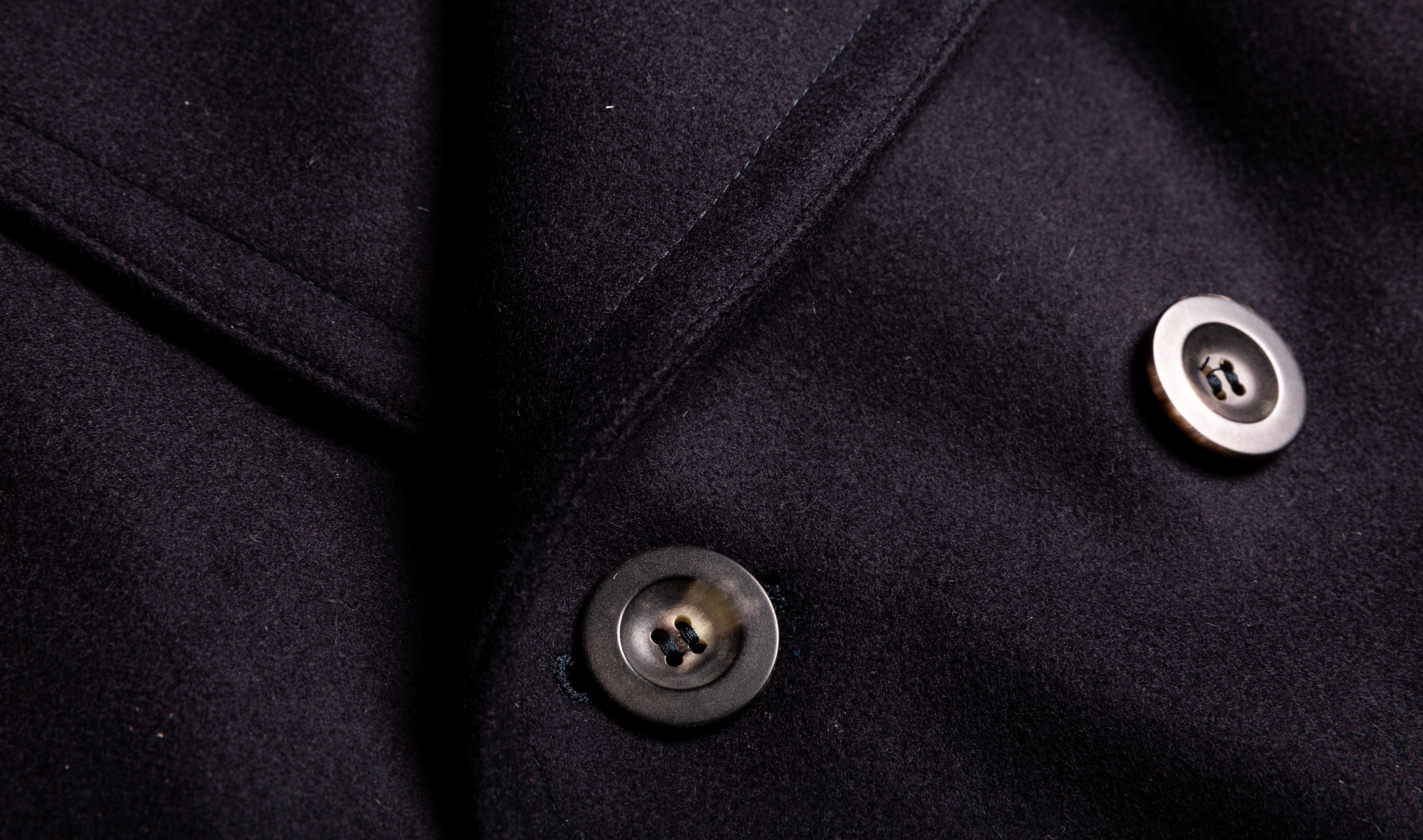The Wax Walker
Every year for the past four years, I've developed a piece of outerwear with the lovely team at Private White V.C. in Manchester.
The aim each time is to realise my version of a classic piece in the male wardrobe, often with elements that I feel are lacking with standard versions - whether its length or lapels, cloth or collar (and most often some combination).
In January this year, we began to think about the English classic, the wax jacket.
I have a few problems with standard designs, but the biggest ones are the very rural colour palette, the length (many are too short) and the slouchy, A-line shape.
In our design - which we're calling the Wax Walker, reflecting its likely use on strolls and dog walks in inclement weather - we tackled all of these.
But we also introduced more than a dozen tweaks that I think hugely improve the style and the practicality of the wax jacket. From a reversible, removable lining to in-seam plunge pockets, they all contribute to make this - strictly in my view - the best in class.
As ever, this article is not short. It runs through all of these elements, what they're for and why I think it makes a difference. But then I know readers value this detailed approach, both so they understand what they're buying, and so they appreciate what they have.
The Private White factory has been making outerwear for decades, for dozens of household names, and its archive is extensive.
The first thing I and the design team did was trawl through this archive, and find examples of wax jackets and field jackets that we liked. There were lots of fascinating details, but the big thing that struck me early was how much nicer the backs of the field jackets were, than the waxes.
A wax jacket is most commonly A-line, running at least straight if not outwards from the shoulders down to the hem. There’s nothing wrong with that, and it is practical, but you can be just as practical and have a more attractive shape, particularly in the back.
The field jackets had that, and so we began designing a back with those details: a broad top with pleats either side (sometimes called an ‘action back’); a half belt that could be cinched at the waist for more shape if you wanted; and two pleats below the belt that picked up those same lines as the action back.
It’s not dissimilar to how a tailor would cut a hunting jacket: fitted in the waist to hold the jacket in place, and then room above and below to allow movement. And the result is just as flattering.
This design also led to some very cool details.
For example, it’s much harder to make an action back out of wax, than it is out of wool (as a field jacket would be). Waxed cotton doesn’t move and drape in the same way, and so the pleats don’t open and close cleanly.
To solve this, Private White V.C. put a panel of wool jersey across the whole top of the back, connecting the inside edges of the two pleats. And, hey presto! The pleats worked perfectly.
It’s still the design element that impresses me most, to be honest. It’s so functional, yet hidden.
Another nice detail - and one that could easily be missed - is the lack of shoulder seam.
The back of the jacket is one piece of material that runs up and over the shoulders, ending halfway down the chest. This means there is no seam on the top that could be a weakness for water.
As with most wax jackets, this is not a true waterproof, just highly water resistant. It’s for a long walk, not serious hiking. But it does help to do little things like move the seams around.
It’s also not possible to tape the seams on wax jackets, as the wax is taken off by the heat used in applying the tape. But, we deliberately used a thicker thread, sewn more slowly, so that the thread fills up the holes when it swells in the wet.
In fact, quite unintentionally Jamie and I tested out the water resistance during this shoot, around the coast of Northern Ireland.
As we started walking down to Kinbane castle, the heavens opened and a gale picked up. The rain was lashing against for the whole hour we were there (and during the drive into Ballycastle). My trousers were wet, my cap was soaked, but the jacket I had on under the wax was fine. Completely covered and not even damp.
As I said, if you’re camping or hiking you need a real waterproof. But for anything less this is absolutely fine. Particularly because wherever you end up, you’ll likely be able to hang it up to dry (unlike when camping).
My beloved old cap also dried perfectly, and was even a little cleaner for the soaking.
As you can see from those pictures, the jacket is deliberately long enough to fully cover a tailored jacket (see bottom of the post for measurements).
And elsewhere I was keen to keep the design as sleek as possible. So the hip pockets are not bellows but flush with the jacket: terrible for holding shells, but good for most else.
And there are plunge pockets above them, on the waist, but they’re cut into the seam that runs down from that shoulder panel, making them much less visible.
Nothing irritates me more than plunge pockets that are just slapped on the outside of a jacket, floating - not aligned with anything else. It just seems so lazy.
The top pockets are lined with cashmere, just like the pockets on our other collaboration coats. But, they’re deep enough so that you can use them for a phone or anything else, if you prefer to put your hands in the hip pockets (as I do, mostly).
So if your jacket is zipped up against the rain and cold, there are plenty of options for storing things and keeping your hands warm.
Plus, there’s one more option just behind the fly front of the jacket: a vertical, zipped pocket that you again can access without having to unzip (just visible below). That’s where I keep my phone most of the time.
That outside-but-covered pocket is really useful, and something I wouldn’t have thought about had it not been for all the trawling through the P.W.V.C. archive.
OK, one more functional point before we move onto the aesthetics.
There is a lining on the jacket, in grey flannel. Great. That lining is removable, so you can wear the jacket in mild conditions as well as cold. Even better. And the lining is reversible, so you can have either side facing outwards. What? Why?
Basically, we had feedback on the Trench Coat that the lining - lovely as it was - made it hard to get the coat on and off. But not everyone said that. So with the Wax Walker, you have the choice.
You can feel the nice wool flannel by keeping it facing outwards; or you can make the jacket super-smooth to get on and off, by having the synthetic facing outwards. You can’t have both, obviously, but either way you benefit from the warmth. Neat right?
So, the aesthetics. As with most of the products we’ve developed, this was intended to be a more urban than a rural piece. Colder, subtle colours, and perhaps a less common combination.
So we went with a very dark-brown waxed cotton, with black corduroy on the collar and ends of the sleeves. The black and brown go very nicely together, and the P.W.V.C. signature copper hardware is always nice with colder colours.
In the photos, as I usually do, I’ve worn the jacket with two different outfits, to show how it looks with both casual clothing (boots, chinos and knit) and a smarter outfit (jacket and flannels).
Along the way though, it also illustrates the range of colours this brown wax works with: grey and green, cream and beige, a blue shirt and a white tee, indigo and bright-red in the accessories.
It might be the most involved piece we’ve ever done, and it’s wonderful to see it finally complete.
Some other details to note:
- There are two internal chest pockets, both buttoned
- There is also a large internal left-hip pocket, not quite big enough for game, but – certainly for a paperback
- There is a water-resistant panel running along the bottom of the inside, sometimes referred to as a ‘drip strip’, to help protect when you sit on a wet surface
- The cuffs have straps and snaps, to fasten against the cold and wet (or if you just – prefer a closer fit, for example when worn without tailoring)
- The waxed cotton is 230g, from Halley Stevenson
- The flannel is 270g, from Marling & Evans
- The coat is entirely made in Manchester, England, by Private White V.C.
Sizing:
- The Wax Walker fits true to size, and is cut straight rather than slim (the waist cinch enables it to be slimmer if you wish)
- In the images I am wearing a size 4 (medium) and am 6 foot tall, with a 39-inch chest
- We highly recommend comparing the measurements below to a coat you already own, however, rather than going off body measurements
- All measurements are with the jacket laid flat. Chest is straight across, from 2.5cm under the armpit; waist is taken 47cm down the jacket; length is from the bottom of the collar to the hem
Alterations:
- Alterations on a jacket like this are harder than on other pieces like the Bridge Coat or Donegal Coat, both because of the complication of the design and because of the waxed cotton material. But other than length, there is also less point to them
- You can take in the body slightly, but no more than an inch in total, and the liner may would need to be taken in as well. But there is perhaps little point: the waist can be cinched anyway, and the vents and action back make a big difference to the fit elsewhere
- The sleeves can be shortened, but no more than half an inch before getting too close to the studs
- Shortening the body is difficult given the pockets and vents, on the front and back
- Letting out any seams isn't advised, given the holes in the wax material that would show
The Wax Walker
Every year for the past four years, I've developed a piece of outerwear with the lovely team at Private White V.C. in Manchester.
The aim each time is to realise my version of a classic piece in the male wardrobe, often with elements that I feel are lacking with standard versions - whether its length or lapels, cloth or collar (and most often some combination).
In January this year, we began to think about the English classic, the wax jacket.
I have a few problems with standard designs, but the biggest ones are the very rural colour palette, the length (many are too short) and the slouchy, A-line shape.
In our design - which we're calling the Wax Walker, reflecting its likely use on strolls and dog walks in inclement weather - we tackled all of these.
But we also introduced more than a dozen tweaks that I think hugely improve the style and the practicality of the wax jacket. From a reversible, removable lining to in-seam plunge pockets, they all contribute to make this - strictly in my view - the best in class.
As ever, this article is not short. It runs through all of these elements, what they're for and why I think it makes a difference. But then I know readers value this detailed approach, both so they understand what they're buying, and so they appreciate what they have.
The Private White factory has been making outerwear for decades, for dozens of household names, and its archive is extensive.
The first thing I and the design team did was trawl through this archive, and find examples of wax jackets and field jackets that we liked. There were lots of fascinating details, but the big thing that struck me early was how much nicer the backs of the field jackets were, than the waxes.
A wax jacket is most commonly A-line, running at least straight if not outwards from the shoulders down to the hem. There’s nothing wrong with that, and it is practical, but you can be just as practical and have a more attractive shape, particularly in the back.
The field jackets had that, and so we began designing a back with those details: a broad top with pleats either side (sometimes called an ‘action back’); a half belt that could be cinched at the waist for more shape if you wanted; and two pleats below the belt that picked up those same lines as the action back.
It’s not dissimilar to how a tailor would cut a hunting jacket: fitted in the waist to hold the jacket in place, and then room above and below to allow movement. And the result is just as flattering.
This design also led to some very cool details.
For example, it’s much harder to make an action back out of wax, than it is out of wool (as a field jacket would be). Waxed cotton doesn’t move and drape in the same way, and so the pleats don’t open and close cleanly.
To solve this, Private White V.C. put a panel of wool jersey across the whole top of the back, connecting the inside edges of the two pleats. And, hey presto! The pleats worked perfectly.
It’s still the design element that impresses me most, to be honest. It’s so functional, yet hidden.
Another nice detail - and one that could easily be missed - is the lack of shoulder seam.
The back of the jacket is one piece of material that runs up and over the shoulders, ending halfway down the chest. This means there is no seam on the top that could be a weakness for water.
As with most wax jackets, this is not a true waterproof, just highly water resistant. It’s for a long walk, not serious hiking. But it does help to do little things like move the seams around.
It’s also not possible to tape the seams on wax jackets, as the wax is taken off by the heat used in applying the tape. But, we deliberately used a thicker thread, sewn more slowly, so that the thread fills up the holes when it swells in the wet.
In fact, quite unintentionally Jamie and I tested out the water resistance during this shoot, around the coast of Northern Ireland.
As we started walking down to Kinbane castle, the heavens opened and a gale picked up. The rain was lashing against for the whole hour we were there (and during the drive into Ballycastle). My trousers were wet, my cap was soaked, but the jacket I had on under the wax was fine. Completely covered and not even damp.
As I said, if you’re camping or hiking you need a real waterproof. But for anything less this is absolutely fine. Particularly because wherever you end up, you’ll likely be able to hang it up to dry (unlike when camping).
My beloved old cap also dried perfectly, and was even a little cleaner for the soaking.
As you can see from those pictures, the jacket is deliberately long enough to fully cover a tailored jacket (see bottom of the post for measurements).
And elsewhere I was keen to keep the design as sleek as possible. So the hip pockets are not bellows but flush with the jacket: terrible for holding shells, but good for most else.
And there are plunge pockets above them, on the waist, but they’re cut into the seam that runs down from that shoulder panel, making them much less visible.
Nothing irritates me more than plunge pockets that are just slapped on the outside of a jacket, floating - not aligned with anything else. It just seems so lazy.
The top pockets are lined with cashmere, just like the pockets on our other collaboration coats. But, they’re deep enough so that you can use them for a phone or anything else, if you prefer to put your hands in the hip pockets (as I do, mostly).
So if your jacket is zipped up against the rain and cold, there are plenty of options for storing things and keeping your hands warm.
Plus, there’s one more option just behind the fly front of the jacket: a vertical, zipped pocket that you again can access without having to unzip (just visible below). That’s where I keep my phone most of the time.
That outside-but-covered pocket is really useful, and something I wouldn’t have thought about had it not been for all the trawling through the PWVC archive.
OK, one more functional point before we move onto the aesthetics.
There is a lining on the jacket, in grey flannel. Great. That lining is removable, so you can wear the jacket in mild conditions as well as cold. Even better. And the lining is reversible, so you can have either side facing outwards. What? Why?
Basically, we had feedback on the Trench Coat that the lining - lovely as it was - made it hard to get the coat on and off. But not everyone said that. So with the Wax Walker, you have the choice.
You can feel the nice wool flannel by keeping it facing outwards; or you can make the jacket super-smooth to get on and off, by having the synthetic facing outwards. You can’t have both, obviously, but either way you benefit from the warmth. Neat right?
So, the aesthetics. As with most of the products we’ve developed, this was intended to be a more urban than a rural piece. Colder, subtle colours, and perhaps a less common combination.
So we went with a very dark-brown waxed cotton, with black corduroy on the collar and ends of the sleeves. The black and brown go very nicely together, and the P.W.V.C. signature copper hardware is always nice with colder colours.
In the photos, as I usually do, I’ve worn the jacket with two different outfits, to show how it looks with both casual clothing (boots, chinos and knit) and a smarter outfit (jacket and flannels).
Along the way though, it also illustrates the range of colours this brown wax works with: grey and green, cream and beige, a blue shirt and a white tee, indigo and bright-red in the accessories.
It might be the most involved piece we’ve ever done, and it’s wonderful to see it finally complete.
Some other details to note:
- There are two internal chest pockets, both buttoned
- There is also a large internal left-hip pocket, not quite big enough for game, but – certainly for a paperback
- There is a water-resistant panel running along the bottom of the inside, sometimes – – referred to as a ‘drip strip’, to help protect when you sit on a wet surface
- The cuffs have straps and snaps, to fasten against the cold and wet (or if you just – prefer a closer fit, for example when worn without tailoring)
- The waxed cotton is 230g, from Halley Stevenson
- The flannel is 270g, from Marling & Evans
- The coat is entirely made in Manchester, England, by Private White V.C.
Sizing:
- The Wax Walker fits true to size, and is cut straight rather than slim (the waist cinch enables it to be slimmer if you wish)
- In the images I am wearing a size 4 (medium) and am 6 foot tall, with a 39-inch chest
We highly recommend comparing the measurements below to a coat you already own, however, rather than going off body measurements - All measurements are with the jacket laid flat. Chest is straight across, from 2.5cm under the armpit; waist is taken 47cm down the jacket; length is from the bottom of the collar to the hem
Alterations:
- Alterations on a jacket like this are harder than on other pieces like the Bridge Coat or Donegal Coat, both because of the complication of the design and because of the waxed cotton material. But other than length, there is also less point to them
- You can take in the body slightly, but no more than an inch in total, and the liner may would need to be taken in as well. But there is perhaps little point: the waist can be cinched anyway, and the vents and action back make a big difference to the fit elsewhere
- The sleeves can be shortened, but no more than half an inch before getting too close to the studs
- Shortening the body is difficult given the pockets and vents, on the front and back
- Letting out any seams isn't advised, given the holes in the wax material that would show






Leave a comment
This site is protected by hCaptcha and the hCaptcha Privacy Policy and Terms of Service apply.